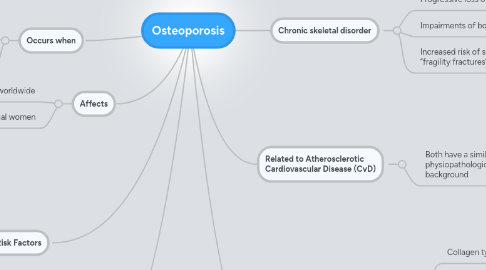
1. BMD heritability
1.1. determined by genetic factors in 50–85% of the cases
1.2. varies with different skeletal sites
2. Occurs when
2.1. Bone resorption occurs too rapidly
2.2. Replacement process is too slow
3. Affects
3.1. about two hundred million people worldwide
3.2. onethird of all postmenopausal women
4. Risk Factors
4.1. Modifiable Factors
4.1.1. poor nutrition
4.1.2. Vitamin D deficiency
4.1.3. low body mass index
4.1.4. smoking
4.1.5. alcohol abuse
4.1.6. Inadequate physical act.
4.1.7. Falling
4.2. Fixed Factors
4.2.1. Ethnicity
4.2.2. Age
4.2.3. Small stature
4.2.4. Gender
4.2.5. Genetics
5. Genetic Determinants of Osteoporosis
5.1. Independent of BMD
5.2. bone geometry
5.3. bone turnover
5.4. risk of falling
6. Chronic skeletal disorder
6.1. Progressive loss of bone substance
6.2. Impairments of bone microarchitecture
6.3. Increased risk of so-called “fragility fractures”
7. Osteoporosis-related Genes
7.1. Collagen type I
7.1.1. essential protein of bone matrix
7.1.2. consists of alfa1(1) protein chain
7.1.3. consists of alfa1(2) protein chain
7.2. vDr-vitamin D
7.2.1. regulation of calcium-phosphate homeostasis
7.2.2. increasing the absorption or reabsorption of calcium
7.2.3. tested in relation to osteoporosis through BMD
7.3. ESR Gene(estrogen)
7.3.1. acquisition and maintenance of bone mass
7.3.2. receptor gene ESr1
7.4. IL6
7.4.1. Increased in postmenopausal women
7.4.2. related to the decline of estrogen are associated with bone loss
7.4.3. estrogen deficiency
7.5. LRP5 and LRP6
7.5.1. co-receptors for regulating osteoblast activity and bone formation
8. Related to Atherosclerotic Cardiovascular Disease (CvD)
8.1. Both have a similar physiopathological and genetic background
8.1.1. calcium metabolism
8.1.1.1. affects both bone mineralization and the development and progression of arteriosclerosis
8.1.2. Osteoprotegerin and rANK
8.1.2.1. regulate osteoclast activation
8.1.2.2. involved in vascular calcification and atherosclerosis
8.1.3. age-related estrogen deficiency
8.1.3.1. stimulates the generation of pro-inflammatory cytokines
8.1.3.2. a decrease in osteoprotegerin production
8.1.3.3. facilitates development of atherosclerosis plaques
